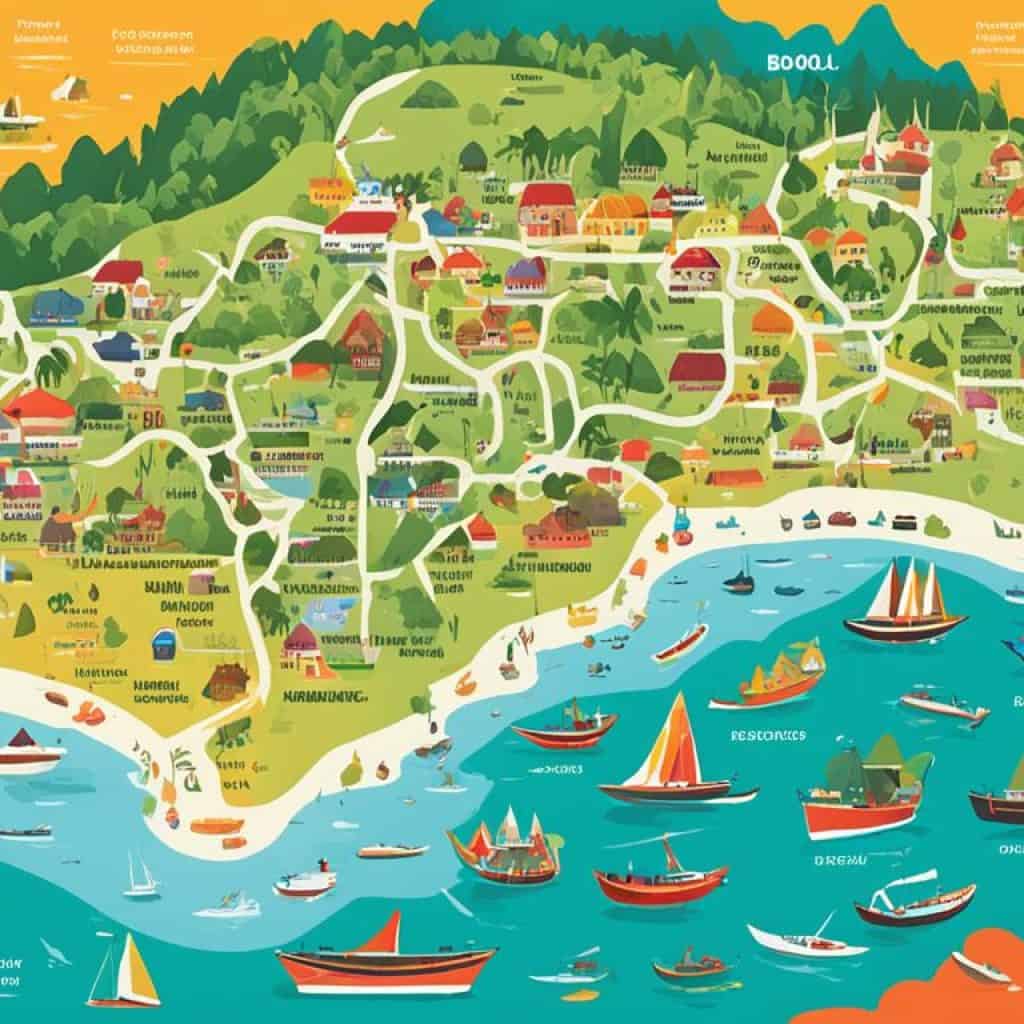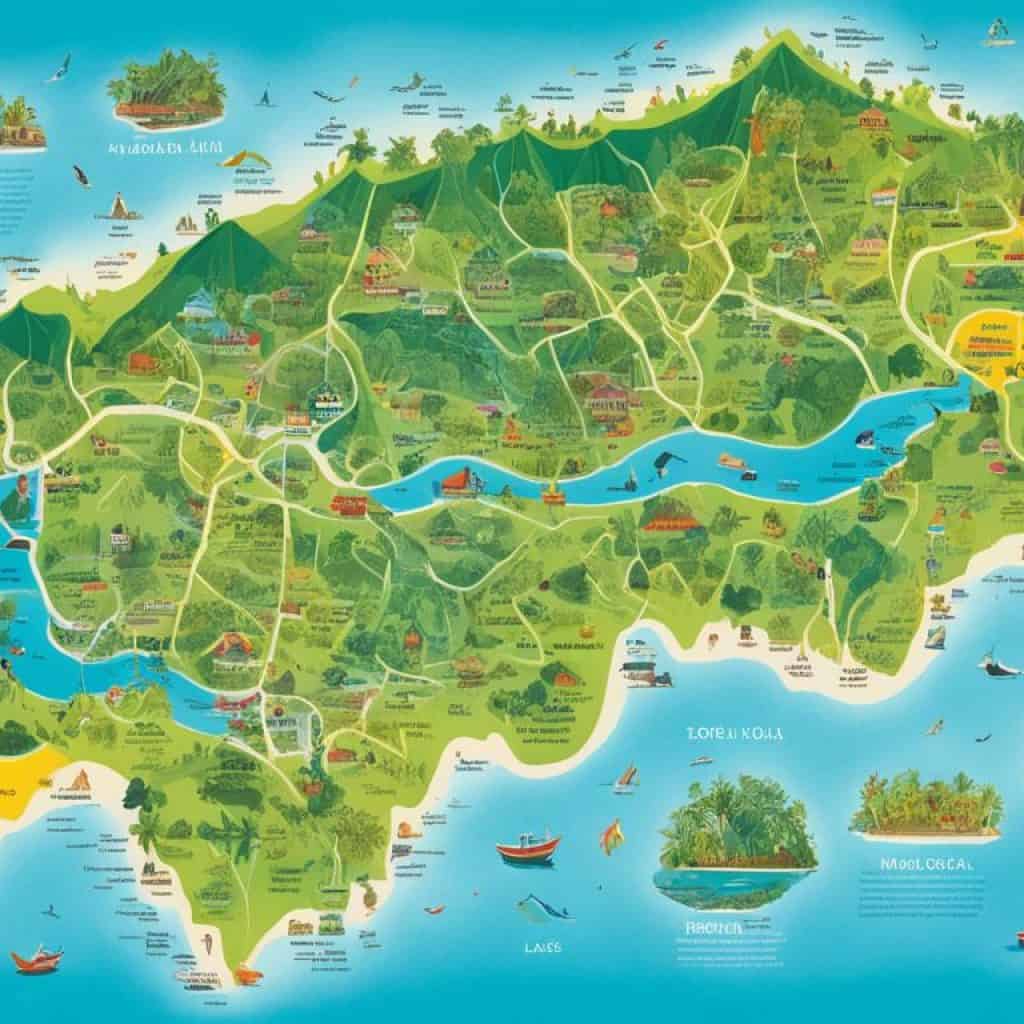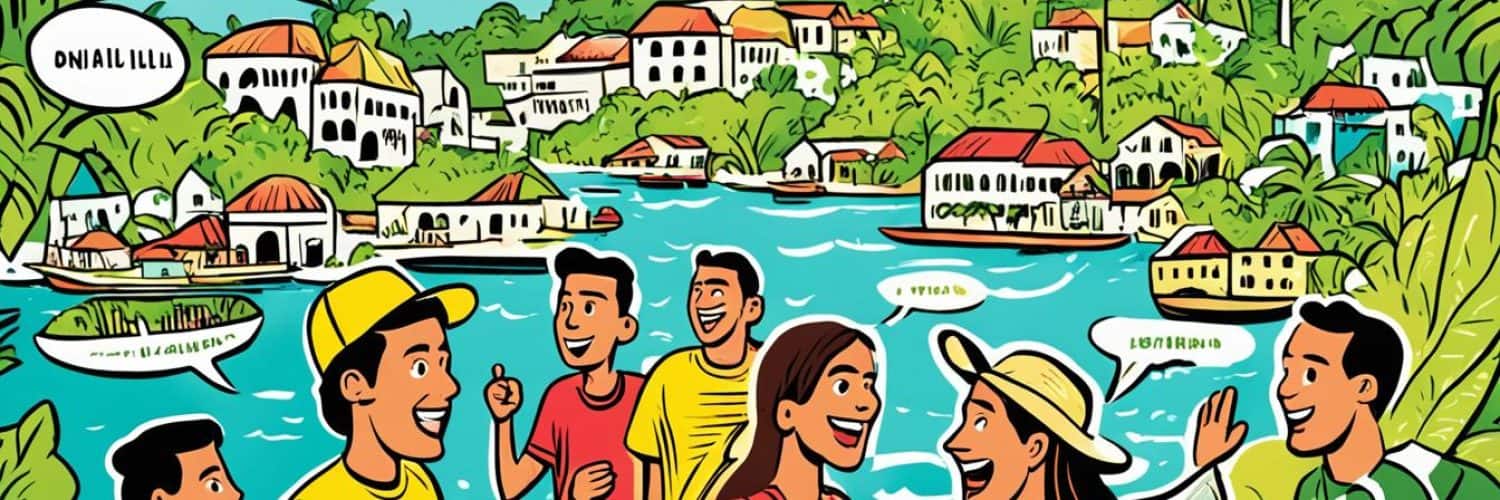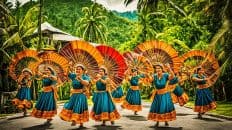Are you curious about the linguistic intricacies of the Bohol dialect? Have you ever wondered how this distinct native tongue reflects the cultural heritage of the Boholano people?
Bohol Island in the Philippines boasts a fascinating linguistic gem known as the Bohol dialect, also referred to as the Boholano language. This dialect is part of the Visayan language family, specifically linked to the Cebuano dialect. It has its own unique linguistic features and variations.
By understanding the Bohol dialect, you uncover the linguistic diversity of the Philippines. You also gain insights into the cultural nuances of the Boholano community.
Key Takeaways:
- The Bohol dialect is the native tongue of the people of Bohol Island in the Philippines.
- It is a unique dialect within the Visayan language family.
- The Bohol dialect reflects the rich cultural heritage of the Boholano people.
- Studying the Bohol dialect provides insights into linguistic diversity and cultural nuances.
- The Bohol dialect has its own distinct linguistic characteristics and variations.
The History and Origins of the Bohol Dialect
The Bohol dialect, known as Boholano, has a rich history. It started during the early Spanish colonization in the Philippines. It formed from the mix of local Boholano and Spanish languages, creating a unique dialect. Over time, it evolved, blending Spanish and other regional dialects.
Now, the Bohol dialect showcases the Boholano’s cultural richness and diversity. It shows the blend of cultures and languages that shaped Bohol’s identity. Exploring its history offers insights into Bohol’s unique language and how it stands out among the Visayan dialects.
“The Bohol dialect represents the cultural and linguistic heritage of the Boholano people, serving as a bridge between the past and the present.”
The dialect’s growth highlights the Boholano community’s resilience. It mirrors the history of colonization and the original language of Bohol’s people. This mix of languages is a sign of the diverse cultures in the Philippine archipelago.
Looking into the Bohol dialect’s past shows how language can change and adapt. It underscores the role of language in capturing a community’s cultural essence. It offers a glimpse into the Boholano people’s lives and stories.
Linguistic Analysis of the Bohol Dialect
Exploring the Bohol dialect reveals fascinating linguistic features. Its unique traits set it apart from other Visayan dialects. This makes studying it an interesting journey.
One notable characteristic is the dialect’s unique syllable structures. These differences in syllable composition make the Boholano language stand out. It adds a rhythmic flow and melodic quality to the dialect.
The phonetics of the dialect show distinct consonant clusters and vowel sounds. These features enrich the language. They captivate both native speakers and those who love linguistics.
The Bohol dialect also shows regional speech patterns. These are influenced by location and history with other communities. These variations add to the language’s diversity. They help us understand how the dialect has developed.
Language Domains and Usage of the Bohol Dialect
The Bohol dialect, known as Boholano, is more than just a way to talk. It’s important for many language areas. It’s used in everyday chat, family talks, and community events. This makes it a key part of the Boholano people’s life.
This dialect is also central in religious and cultural events. During baptisms, weddings, or festivals, it links people to their culture. It becomes a way to show who they are.

But, it’s key to know that not everyone reads or writes Boholano as well as Filipino. Filipino is taught in schools and often used in writing and formal spots. Still, many in Bohol can speak both languages well.
Boholanos embrace being bilingual. This helps them use their dialect every day and connect with more people in the Philippines. They can easily switch between languages. This keeps their culture strong while reaching out to others.
Grammatical Features of the Bohol Dialect
The Bohol dialect is unique like other Visayan dialects. It has its own grammar rules that make it different. Its sentence structures, verb conjugations, and noun declensions add to this uniqueness.
The Bohol dialect uses a verb-subject-object (VSO) word order. This is different from English which uses subject-verb-object (SVO). This change in word order changes how ideas are expressed.
In the Bohol dialect, certain rules and particles add clarity. They emphasize specific parts of speech. These nuances reflect the culture and worldview of the Boholanos.
Studying the Bohol dialect’s grammar lets us see its cultural and linguistic depth. We learn about the language’s traits. And we understand how it shapes the identity of its people.
To show how the Bohol dialect works, here are some examples:
“Mokaon ko’g pinya.”
Translation: “I will eat pineapples.”
“Dako ang balay niya.”
Translation: “His house is big.”
“Magduwa ang mga bata.”
Translation: “The children are playing.”
Comparison between English and the Bohol Dialect
| Language | Word Order | Example |
|---|---|---|
| English | Subject-Verb-Object (SVO) | “She reads a book.” |
| Bohol Dialect | Verb-Subject-Object (VSO) | “Basa siya ug libro.” |
English uses SVO, but the Bohol dialect uses VSO. This shows the differences between the two languages. It helps us understand the Bohol dialect better.
Knowing the Bohol dialect’s grammar improves language appreciation. It helps us connect with the Boholano community. It allows us to communicate better and appreciate the dialect’s subtleties.
Cultural Significance of the Bohol Dialect
The Bohol dialect is more than just a way to talk for the Boholano people. It holds great cultural importance. It is a tool for keeping their rich traditions, values, and beliefs alive.
Art forms like folk songs, poems, and stories find life in the Bohol dialect. These forms of art are key in keeping Bohol’s culture alive. They help future generations connect with their roots. They also help them understand what it means to be Boholano.
“The Bohol dialect is the voice of our ancestors, carrying the stories and wisdom of our people. It is through our language that we express our identity and maintain our connection with our cultural heritage.” – Local Boholano Elder
During cultural celebrations and festivals, the Bohol dialect shines. It helps express the community’s identity and pride. It brings to life traditional dances, religious ceremonies, and customs. Through these, the Bohol dialect knits Boholano culture together.
The image depicts a vibrant cultural performance that showcases the Bohol dialect as part of a celebration.
The Boholano people strive to keep their language alive. They understand its importance in preserving their collective memory. They are dedicated to teaching the dialect to the youth. This ensures its survival in our modern, fast-paced world.
The Role of Education and Awareness
Education is key in protecting the Bohol dialect. Schools teach it as part of their programs. This way, students learn more than just the language. They also grow to appreciate their cultural heritage.
Beyond school, community groups and initiatives also promote the dialect. They organize workshops and cultural exchanges. These events allow people to dive deep into Boholano culture and traditions.
This cultural significance, inherent in the Bohol dialect, fosters a sense of pride and belonging among the Boholano people. The language becomes a bridge connecting the past with the present, and the preservation of the dialect ensures that the cultural heritage of Bohol continues to thrive.
Challenges and Preservation Efforts for the Bohol Dialect
Keeping the Bohol dialect alive is key for our cultural diversity and heritage. But, this dialect faces many challenges today. The main threats are the growing use of the national language and globalization’s effects.
Many are working hard to save and spread the use of the Bohol dialect. Groups focused on language preservation, schools, and locals are all doing their part. They all aim to show how critical this dialect is and work towards its preservation.
“The Bohol dialect is not just a language; it is a key to our cultural identity,” says Maria Santos, a language preservation advocate. “By preserving our dialect, we ensure that future generations can connect with our rich cultural heritage.”
Efforts to record and digitize the dialect are in full swing. These activities include taping conversations, oral literature, and traditional songs. It’s all to make sure this unique language’s details are saved for the future.
There’s also a big push in schools to teach the Bohol dialect. They want to teach its importance and encourage kids to speak it proudly.
Bohol Dialect Preservation Initiatives:
- Collaboration with local communities to create language revitalization programs
- Establishment of language centers and immersion programs to promote the use of the Bohol dialect
- Development of language learning materials and resources for children and adults
| Challenges | Preservation Efforts |
|---|---|
| The influence of the national language | Advocacy for the recognition and importance of the Bohol dialect |
| Globalization and cultural assimilation | Integration of the dialect in educational institutions and community programs |
| Declining number of fluent speakers | Creation of language revitalization programs and resources |
Successful preservation of the Bohol dialect is a team effort. It needs the commitment of language groups, schools, and every Boholano. By valuing and sharing the Bohol dialect, we protect the deep cultural roots of the Boholano people for those to come.

The Importance of Studying the Bohol Dialect
Learning about the Bohol dialect helps us appreciate the Philippines’ rich languages. It shows us the unique culture of the Boholano people. We can also see how different the Visayan languages are.
By studying this dialect, we learn about history and culture. We understand how they impact language. This helps protect and celebrate all languages. It’s crucial for the study of languages and cultures.
Exploring Bohol: Immerse Yourself in the Boholano Culture
To truly experience Boholano culture, it’s best to dive into local life. This means engaging with the Bohol dialect. This dialect isn’t just for talking. It shows the rich cultural heritage of Bohol. By learning the Boholano language, you get closer to understanding the traditions and nuances of the area.
Where to Learn the Bohol Dialect
If you’re interested in the unique Bohol dialect, many resources can help. You can pick from traditional classes or modern online platforms. Each option suits different learning styles and preferences.
Local Language Centers and Community Organizations
To learn the Bohol dialect, try classes or workshops at local language centers. They have skilled instructors to guide you. This structured setting offers a complete language learning experience.
Language Exchange Programs
Language exchange programs are another great option. They let you meet native Boholano speakers eager for language exchange. This way, you improve your skills and make local friends.
Online Platforms and Language Learning Apps
For those who like learning at their own pace, online resources are available. They offer lessons, exercises, and pronunciation help for the Bohol dialect. With your device, you can easily access and practice anytime.
Interaction with Native Boholano Speakers
Direct interaction with native speakers is very effective. If you’re in Bohol, talk with the locals every chance you get. This real-life practice will boost your understanding and skills fast.
Immersive Language Learning Experience
Immersing yourself in Boholano culture helps you understand the dialect better. Join cultural exchanges, live with local families, and go to festivals. These experiences enhance language learning and let you appreciate Bohol’s culture deeply.
“Learning the Bohol dialect is a rewarding endeavor that allows you to connect with the Boholano community on a deeper level and unlock the cultural richness of the region.” – Language Learning Enthusiast
Whichever method you choose, remember that language learning needs patience, practice, and an open mind. Enjoy the challenge and journey as you dive into the Bohol dialect and culture.
The Future of the Bohol Dialect
The Bohol dialect’s future relies on everyone in the Boholano community. Also, language groups and schools play a big part. It’s key to keep using the dialect and help it grow. By seeing its value and celebrating its culture, Boholano people can keep it alive for the future.
The Bohol dialect is a big piece of the Boholano’s culture. To keep it going, the community must work to save and use it more. Groups focused on saving languages are also vital. They help by recording the dialect and making digital versions for others to learn.
Schools play an important role too. They teach the dialect, ensuring kids learn and value their language. By making it part of the curriculum, young people can become skilled in speaking it. They also learn to support and spread their language.
“Preserving the Bohol dialect isn’t just about words; it’s about keeping our Boholano identity and culture alive.” – Maria Santos, Boholano language supporter
To keep the dialect going, use it in your daily life. Use it at home, in community gatherings, and during cultural festivals. This way, the dialect stays a part of Boholano identity and heritage.
The Importance of Language Sustainability
Keeping languages alive is crucial for cultural diversity and identity. Each language offers a unique view of the world. It carries cultural knowledge and traditions. When a language disappears, we lose a lot of history and wisdom.
So, saving the Bohol dialect means more than just keeping a language. It’s about preserving the Boholano people’s rich culture. The dialect connects us to our history, beliefs, and knowledge from our ancestors.
Collaboration for a Vibrant Future
A bright future for the Bohol dialect needs teamwork. The Boholano community, language savers, and schools must work together. They can start projects that encourage using the dialect and teach its importance.
“Saving a language is something we all should be part of. Together, we can make the Bohol dialect strong and a source of pride for everyone.” – Dr. Antonio Gomez, Language Professor
Celebrating the Bohol dialect helps keep it used and valued. Saving a language is more than preserving words. It’s about keeping a culture alive and keeping the Boholano’s unique character.
The Future is in Our Hands
The Bohol dialect’s future depends on the Boholano people’s dedication to their culture. By using the dialect, learning it, and supporting saving efforts, they can keep the dialect vibrant. This ensures it’s around for many years to come.
| Challenges | Solutions |
|---|---|
| The increasing influence of the national language and globalization | Promote the use of the Bohol dialect in various domains and create opportunities for language revitalization |
| Limited literacy in the Bohol dialect | Incorporate the dialect into formal education and provide resources for language learning |
| Lack of awareness about the importance of language preservation | Raise awareness through community engagement, cultural events, and media campaigns |
The Bohol dialect’s success lies with the Boholano community. By joining language saving activities and building cultural pride, they can keep their special dialect alive. This way, it continues to influence Bohol’s culture.
Conclusion
The Bohol dialect is more than just words. It’s the soul of Bohol Island’s culture in the Philippines. It shows the deep heritage of the area. Researchers work hard to study its unique qualities and history.
This dialect is vital for the Boholano people. It’s a key way to keep their culture alive. Through it, they share traditions, values, and beliefs across generations.
Looking ahead, it’s key we keep this dialect alive. Preserving it through education is essential. This way, everyone can appreciate the rich culture and diversity of Bohol.


















Add comment